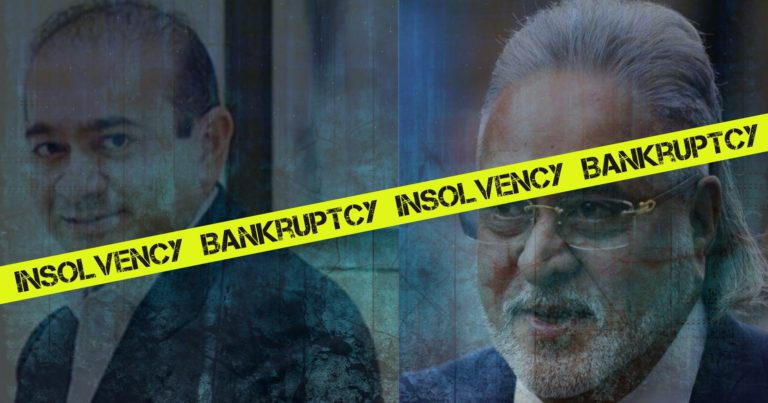Being Bankrupt or Being Insolvent: How Different?
Thanks to the recent episode of Vijay Mallya & others, the issue of Bankruptcy & Insolvency have garnered substantial public attention which has never been a much-debated issue in the public domain a few years back. While few attempts such as enactment of Insolvency & Bankruptcy Code intending to make India a favorable destination for doing business have also added fuel to the fire thus, triggered the debate over the issue of Bankruptcy & Insolvency. In common parlance, both words are used interchangeably, but there lies a difference between the two. Insolvency refers to the financial state of a person or corporation when they are unable to pay debts or discharge their financial obligation either because of a lack of available cash at the relevant time or, more fundamentally because total liabilities exceed the value of assets which can be made available to meet them. While in the case of bankruptcy first situation remains the same, i.e., non-availability of cash or funds for paying off the debts, but the total value of the debtor’s assets is realizable out of which the payments can be made to satisfy the debt/liabilities as per the order of the court.
A code in continuity
The Insolvency and Bankruptcy Code (2016), has been the talk of the town since its inception for several reasons. There has been growing clamor all around about ease of doing business in India. The transitional shift in the role of the State with the passage of time from ‘actor’ to ‘facilitator’ has changed the objectives of economic progress of our country. Owing to technological advancement promotion of trade for sustaining and appreciating the scales of economic benefits now becomes the global order and India is no exception in following such global norms. India being a member of the WTO has progressed significantly to remain at par with the dynamic global economic landscape and emphasized upon the Policies wherein Law and Legal system become an integral part within the fold of such Policies.
To cater to the need of the hour the instant code has undergone a series of amendments which is still a continuing process. No doubt the enactment is a significant positive stride which our legislature has taken. Fixing the time limit of 180 days (extendable up to 90 days) for insolvency resolution process, the appointment of insolvency professionals, constitution of insolvency resolution board, insolvency and bankruptcy fund, adjudicating authorities are some of the laud features of the code among various other provisions. But, at the same time, our regulators need to understand that in this era of globalization business activities are now not just confined to a particular territory instead it has transcended the geographical boundaries. Thus it becomes very crucial for us to ponder over issues/ situation which involves other jurisdictions. The present piece aims to point out and provide a possible option on one of the key issue (i.e. “Cross-Border Insolvency) which the amendments to the Code in Continuity have missed completely.
What it meant for doing business & why India needed a comprehensive code?
It is an undisputed fact that doing business and promoting economic activities to a great extent depends upon how efficient the laws and regulatory framework are in a particular country. An efficient, transparent and well defined regulatory framework forms the bedrock of the market economy. It is an inevitable fact that certain business fails to such an extent that it becomes almost impossible to revive them. At that stage, it becomes more pertinent to close the business rather than carrying it forward. The problem intensifies further when the claims of creditors and other stakeholder come to the fore. Until the enactment of Insolvency & Bankruptcy Code India lacked a single codified law to deal with the situation of insolvency which in simple term means the situation where the companies are unable to pay their outstanding debts. The insolvency and bankruptcy proceedings in India were initially governed under the host of laws such as Companies Act 2013, Sick Industrial Companies (special provisions), Act 1985, Recovery of Debts Due to Banks & Financial Institutions Act, 1993. The Presidency Towns Insolvency Act 1909; The Provincial Insolvency Act 1920.
The present regime was trapped in the catacomb of multiple regulators and a catena of complex regulatory requirement which made it cumbersome to carry out business in a hostile environment. On an average India takes as much as 4.3 years to shut an unviable business twice as much as China, and 1.7 years in developed economies. The operation of the Sick Industrial Companies (Special Provisions) Act, 1985 (“SICA”) has attracted scathing criticism almost since its enactment for its lengthy delays in determining the viability of sick enterprises and for lending itself to significant abuse by debtor companies looking to siphon off their assets from creditors. Another commonly heard complaint was the implementation of winding up and liquidation proceedings in the High Courts, which could take years or decades to be completed. Thus, enactment of the code was the need of the hour.
Where do we lack and the way forward?
When it comes to the Cross-Border insolvency Although, the present code has treated the foreign creditors at par with domestic creditors, the entire procedural frameworks in IBC, 2016 would encourage to develop multifarious issues, viz; a) Jurisdictional Issue in case of TNCs or MNCs whose corporate citizenship is not India; b) Appointment of Insolvency Resolution Professional in case of Foreign Creditors – whether they can nominate the IRP of their own choice or bound to choose those listed in the official records of Insolvency and Bankruptcy Board of India? c) Whether the Decretal-amount shall come within the tax net of the country or not? Etc. The practices in foreign investment and cross-border insolvency mostly take recourse to either Bilateral Investment Treaties (BIT’s) or Multilateral Investment Treaties (MIT’s) and the bilateral agreements for ensuring effective compliance.
The IBC, 2016 has focused upon the principle of Reciprocity as followed under Section 44-A of the Code of Civil Procedure. It may palpably depreciate the maximization of returns to the Creditors. On a careful reading of the provisions of the UNCITRAL Model Laws on Insolvency, it seems that the approach recommended therein could have sustained the confidence of Foreign Investors if those provisions would have found their place in IBC, 2016 in addressing the cross-border issues. Taking inspiration from countries like the UK, US, Australia, and Japan. I strongly believe that the code should have followed the UNCITRAL Model Law which identifies four elements i.e. (a) Access (b) recognition (c) relief (d) coordination and cooperation as key to the conduct of cross-border insolvency cases. I can foresee that adopting the Model Law will have umpteen benefits for our country. It is a recognized international standard and makes negotiations to consume less time by simplifying the recognition process and also allows the recognition proceedings. Thus, it provides the fair and efficient administration with greater legal certainty thereby increasing the investors’ confidence which is indeed the need of the hour to remain at par with the dynamic global economic landscape. Model Law on the grounds of public policy also gives a scope where we would be permitted to make changes to suit our particular needs while enacting the legislation based on model law. Let’s hope that the legislature takes the proper steps at the earliest and pave the way to realize the dream of every Indian, i.e., to see India as an economic superpower and a self-reliant nation.
Further; Read More:
Vaibhav Raut’s arrest: a battery of questions to the scrappy affair of Maha ATS
Once upon a time in Gujarat: Police had assaulted Chief Judicial Magistrate!



